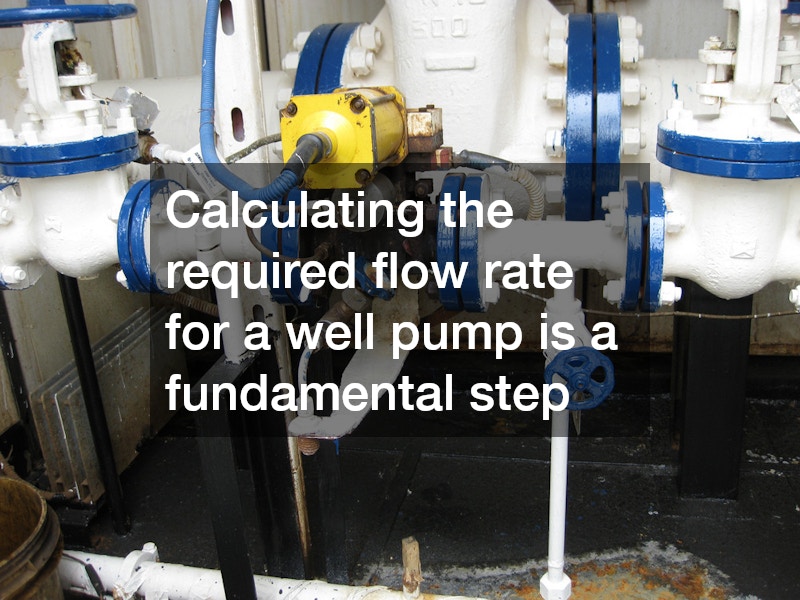There are various critical considerations professionals take into account when determining the proper sizing for well pump replacement, ensuring efficiency and reliability in water supply systems. Learn the process these experts follow.
Factors in Well Pump Sizing
When determining the proper sizing for a well pump, professionals must consider several key factors that directly impact the overall performance of the water system. These factors include the flow rate, the depth of the well, and the static water level.
Each of these elements plays a crucial role in selecting the appropriate pump that meets water supply demands sustainably.
Another essential factor is the type of pump technology being considered. Varying pump designs cater to specific conditions and requirements, making it vital to understand the environmental characteristics of the well. Professionals analyze the geological conditions and water quality, ensuring the chosen pump is compatible with the well’s unique attributes.
Additionally, the intended use of the water is also a consideration when sizing a well pump. Whether for residential purposes, irrigation, or commercial use, the demand for water can vary significantly. Experts assess the anticipated water usage patterns and peak demand scenarios to ensure that the pump can handle operational requirements without strain.
Required Flow Rate
Calculating the required flow rate for a well pump is a fundamental step in ensuring that the system meets user needs effectively. The flow rate, usually measured in gallons per minute (GPM), reflects the volume of water needed for daily consumption or specific applications. Professionals use various equations and methods to determine this critical measurement.
To accurately calculate the necessary flow rate, specialists often evaluate factors such as household consumption, irrigation needs, and other water-using fixtures. Understanding how many fixtures may be drawing water simultaneously helps professionals estimate the peak flow requirement. This analysis ensures that water delivery remains consistent, even during high-demand periods.
Moreover, professionals sometimes utilize flow tests, where they measure the delivery capacity of the well under controlled conditions. This approach assists in confirming calculations and helps identify any discrepancies or needs for adjustments in the selected pump model to ensure efficiency and reliability.
Static Water Level
The static water level is a critical parameter that directly influences well pump selection. It refers to the depth at which the water sits in the well when no water is being drawn. Understanding this depth is essential for determining the type of pump and its available capabilities. Professionals take precise measurements to ensure the pump is appropriately positioned within the well.
Furthermore, the static water level helps in identifying the drawdown potential of the well. Drawdown is the difference between the static water level and the water level when the pump is in operation. If the pump is placed too high relative to the static water level, it can lead to insufficient water supply and even pump damage from running dry.
Professionals carefully document these measurements to optimize pump placement while ensuring that the pump operates efficiently without issues. Overall, the static water level provides critical insights that guide pump sizing decisions and help tailor the chosen solution for the user’s specific requirements.
Recovery Rate
The recovery rate of a well is another key factor that professionals take into account when sizing a well pump. This rate indicates how quickly water replenishes itself after the pump has drawn from it. Evaluating the recovery rate is vital because it directly impacts the well’s sustainability and usability for long-term water supply.
To assess the recovery rate, professionals conduct tests where they measure how long it takes for the water level in the well to return to its static level after pumping. These tests help gauge if the well can consistently meet the expected demand, assisting in identifying whether a particular pump size is suitable for long-term use.
If a well exhibits a low recovery rate, it may not support high-capacity pumps without risking depletion of the water source. Thus, understanding the recovery rate allows professionals to select a pump that aligns with the well’s natural replenishment capabilities, ensuring a sustainable and reliable water supply system for years to come.
Common Mistakes
When sizing a well pump, avoiding common mistakes is crucial to ensure optimal performance and longevity. One of the most prevalent errors is underestimating the required flow rate, which often leads to inadequate water pressure and supply. Professionals encourage careful assessment and thorough calculations to prevent this oversight.
Another frequent mistake is neglecting to take into account the well’s recovery rate and static water level. Failing to consider these factors can result in selecting a pump that is either too powerful or insufficient for the system’s actual needs. Understanding these aspects is essential to keep operational costs low and system reliability high.
Lastly, not accounting for future demands can also lead to sizing errors. If a household anticipates an increase in water demand due to future expansions or lifestyle changes, it is unwise to size the pump solely based on current needs. Planning for such developments can save time and money, contributing to a smoothly operating water system that meets all demands.
Correctly sizing a well pump involves a thorough understanding of various factors, including flow rate, static water level, and recovery rate. By avoiding common mistakes, professionals can ensure proper functionality and efficiency in well water systems. Accurate assessments and calculations lead to sustainable solutions that meet current and future water supply needs.



